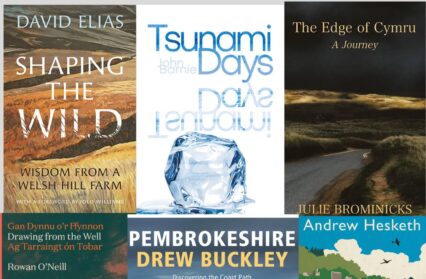While the weather may not be offering much in the way of sunshine right now, Wales Arts Review is here to brighten your summer with our top picks for your summer reads 2023. As we continue our run-down of the books we’re reading this summer, we take a closer look at the non-fiction titles which have caught our attention recently.
Tsunami Days by John Barnie (Cinnamon Press)
We start our list with a collection of essays which ranges across politics, history, culture, ecological disaster, the meaning of truth, poetry, exploring what we really mean by the concept of identity. Barnie shares a window onto the world that is both erudite and particular. This is an honest and poignant collection from a stalwart of Welsh writing; it’s not always an easy read, but Tsunami Days is a collection which forces its readers to think about their own sense of identity.
Earth Meadow by Eironwy Llewellyn and Sara Llewellyn (Graffeg)
A uniquely personal and charming collection of 53 original artworks depicting life in rural Wales from 1930-1944, painted retrospectively from memory by artist Eironwy Llewellyn whilst in her seventies and collated by her daughter, Sara. This lively collection features various scenes which charmingly recall life as it was lived during this period. Each painting is accompanied by commentary by the artist on its context and subjects, creating a uniquely personal and insightful record of the bygone traditions and community activity of rural Wales.
Wild: Wisdom from a Welsh Hill Farm by David Elias (Calon Books)
Conservationist David Elias explores a farm in the Eryri (Snowdonia) National Park in this fascinating new volume and unpacks what it shows us about the gritty reality of trying to reconcile hill farming and caring for nature. Visiting through the seasons, he forms a deep relationship with the land and the people who work it, coming to understand their particular way of life, history and concerns about the future. It is also a farm rich in nature and he brings his experienced eye to how its habitats and wildlife have been shaped by changing farming practices over the generations. Through lyrical prose and first-hand conversations with farmers, Elias also shows what current government policies have achieved – or not achieved – and why it is so important for us to understand what it really takes ensure farming families remain on the land while simultaneously allowing nature to flourish.
Tryweryn: A New Dawn? by Wyn Thomas (Y Lolfa)
This detailed study by Wyn Thomas addresses Liverpool’s controversial flooding of the Tryweryn Valley in North Wales in the 1960s to increase the city’s water supply. Exploring the situation from Liverpool’s perspective, the book also delves into the constitutional journey of the Tryweryn Reservoir Bill; the impact that the construction of the reservoir, Llyn Celyn, had on those directly affected; the political advances that the Welsh nation subsequently experienced, and the outpouring of Welsh cultural expression which also resulted from Cwm Tryweryn’s contentious drowning. Based on over 20 years of research, including comprehensive archival evidence and a wealth of oral testimony, Trywern: A New Dawn? offers one of the most comprehensive reflections on the story of Tryweryn to date.
Holy Wells of Wexford and Pembrokeshire Various (Parthian Books)
Holy Wells of Wexford and Pembrokeshire is a series of five chapbooks commissioned by Ancient Connections, an EU funded arts, heritage and tourism project linking north Pembrokeshire with north Wexford led by Pembrokeshire County Council with partners Wexford County Council, Pembrokeshire Coast National Park Authority and Visit Wexford. The series coincides with the launch of a new pilgrim route; Wexford-Pembrokeshire Pilgrim Way between Ferns in County Wexford and St Davids in Pembrokeshire. The holy wells explored in this series through fiction, essays, photographs, poetry and prints are all on or close to the new pilgrim route.
The Edge of Cymru by Julie Brominicks (Seren Books)
Strictly speaking not a new release as this was published a few months back, but definitely one which suits a summer reading list, The Edge of Cymru is the story of Julie Brominicks’ walk around Wales in the course of a year. As an educator she knew a lot about the country’s natural resources. But as a long established incomer from England and more recent Welsh learner, she wanted to know more about its history, about Wales today, and her place in it. As her walk unwinds the history of Wales is also unwound, from the twenty-first century back to pre-human times, often viewed through an environmental lens. Brominicksʼ observations of the places and people she meets on her journey make a fascinating alternative travelogue about Wales and the lives its people live.
Escape to Gwyrch Castle: A Jewish Refugee Story by Andrew Hesketh (Calon Books)
In 1939, a number of German Jewish refugee children, brought over on the Kindertransport, found themselves in Abergele, North Wales. Their temporary new home? Gwrych Castle, where a Hachshara was being set up: a residential ‘training centre’ aimed at preparing the Jewish children for life on a kibbutz in Israel, where they hoped to be reunited with their families. In this fascinating debut, Andrew Hesketh explores the lesser-told history of the children who lived in this North Wales castle, bringing together their personal memories and experiences to create a unique picture of their experiences.
Pembrokeshire by Drew Buckley (Graffeg)
An idea first conceived as social media posts during lockdown, award-winning professional landscape and wildlife photographer Drew Buckley takes us on a photographer’s journey in his home county of Pembrokeshire in this beautiful new collection of images. Each photo offers an opportunity to discover the entire 186-mile coast path through the seasons, with individual chapters showcasing the views and flora and fauna found in Britain’s only coastal National Park.
You can read our fiction picks for your summer reads here.











